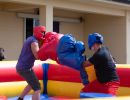Shortly after acquiring the medallions, the pilots’ aircraft was severely damaged by ground fire. He was forced to land behind enemy lines and was immediately captured by a German patrol. In order to discourage his escape, the Germans took all of his personal identification except for the small leather pouch around his neck. In the meantime, he was taken to a small French town near the front. Taking advantage of a bombardment that night, he escaped. However, he was without personal identification.
He succeeded in avoiding German patrols by donning civilian attire and reached the front lines. With great difficulty, he crossed no-man's land. Eventually, he stumbled onto a French outpost. Unfortunately, saboteurs had plagued the French in the sector. They sometimes masqueraded as civilians and wore civilian clothes. Not recognizing the young pilot's American accent, the French thought him to be a saboteur and made ready to execute him. He had no identification to prove his allegiance, but he did have his leather pouch containing the medallion. He showed the medallion to his would-be executioners and one of his French captors recognized the squadron insignia on the medallion. They delayed his execution long enough for him to confirm his identity. Instead of shooting him they gave him a bottle of wine.
Back at his squadron, it became tradition to ensure that all members carried their medallion or coin at all times. This was accomplished through challenge in the following manner - a challenger would ask to see the medallion. If the challenged could not produce a medallion, they were required to buy a drink of choice for the member who challenged them. If the challenged member produced a medallion, then the challenging member was required to pay for the drink. This tradition continued on throughout the war and for many years after the war while surviving members of the squadron were still alive.
According to another story, challenge coins originated during the Vietnam War. Leisure time in Vietnam was a commodity, but when it came, it was utilized to the max; catching up on sleep; writing letters home; letting off steam at the hooch bar. The latter provided to be most popular, but eventually it too could become boring and mundane. To heighten excitement and foster unit esprit de corps, Bullet Clubs were formed. These were comprised of small, elite, front-line fighters who each carried a personalized bullet from the weapons they carried in combat. The ultimate use of the bullet, usually carried in a hip pocket, was to deny the enemy personal capture. When an individual entered the Hooch Bar, he would be challenged by fellow team members to produce his bullet. If he did, the challengers would pay his bar tab for the rest of the evening. If he failed to produce his bullet, he bought the drinks for all the remainder of the night. Eventually, personalized bullets took on disbelieving proportions. Some "teamies" took to carrying 20-, 40-, or 105mm cannon shells. Clearly, these were not personalized coup de grace munitions but rather manifestations of perceived individual prowess in combat or - perhaps - on R & R. At the height of the Bullet Club's heyday, it was not an uncommon sight to see strewn across a barroom table a very respectful representation of the full range of bullets, rockets, cannon and artillery shells used in Southeast Asia. In order to gain control of the situation - and to avoid accidental discharge of the large, fully functional munitions - bullets were traded for coins which reflected the unit's symbol and pride. Each coin was personalized by a controlled number and/or the individual's name. The rules remained the same, although today they are greatly expanded. Loss of one's coins was and remains tantamount to eternal disgrace and banishment. To forget to carry one's coin in anticipation of a challenge results in a minor death.
Challenge Coin Rules
Note: A "Coin Check" consists of a Challenge and a Response.
RULES:
A. The challenge is initiated by drawing your coin, holding it in the air by whatever means possible and state, scream, shout or otherwise verbally acknowledge that you are initiating a coin check. Another, but less vocal method is to firmly place it on the bar, table, or floor (this should produce an audible noise which can be easily heard by those being challenged, but try not to leave a permanent imprint). If you accidentally drop your coin and it makes an audible sound upon impact, then you have just "accidentally" initiated a coin check. (This is called paying the price for improper care of your coin.)
B. The response consists of all those persons being challenged drawing their coin in a like manner.
C. If you are challenged and are unable to properly respond, you must buy a round of drinks for the challenger and the group being challenged.
D. If everyone being challenged responds in the correct manner, the challenger must buy a round of drinks for all those people they challenged.
E. Failure to buy a round is a despicable crime and will require that you turn-in your Coin to the issuing agency.
WHEN - WHERE:
A. Coin checks are permitted, ANY TIME, ANY PLACE.
EXCEPTIONS:
A. There are no exceptions to the rules. They apply to those clothed or unclothed. At the time of the challenge you are permitted one step and an arms reach to locate your coin. If you still cannot reach it -- SORRY ABOUT THAT!
A COIN IS A COIN

 During World War 1, American volunteers from all parts of the country filled the newly formed flying squadrons. Some were wealthy scions attending colleges such as Yale and Harvard who quit in mid-term to join the war. In one squadron, a wealthy lieutenant ordered medallions struck in solid bronze and presented them to his unit. One young pilot placed the medallion in a small leather pouch that he wore about his neck.
During World War 1, American volunteers from all parts of the country filled the newly formed flying squadrons. Some were wealthy scions attending colleges such as Yale and Harvard who quit in mid-term to join the war. In one squadron, a wealthy lieutenant ordered medallions struck in solid bronze and presented them to his unit. One young pilot placed the medallion in a small leather pouch that he wore about his neck.











































